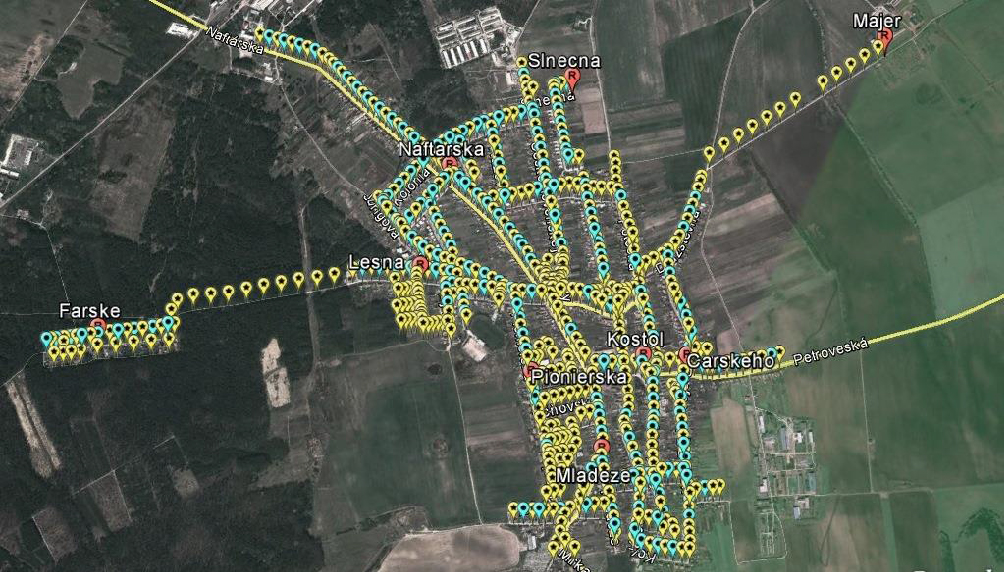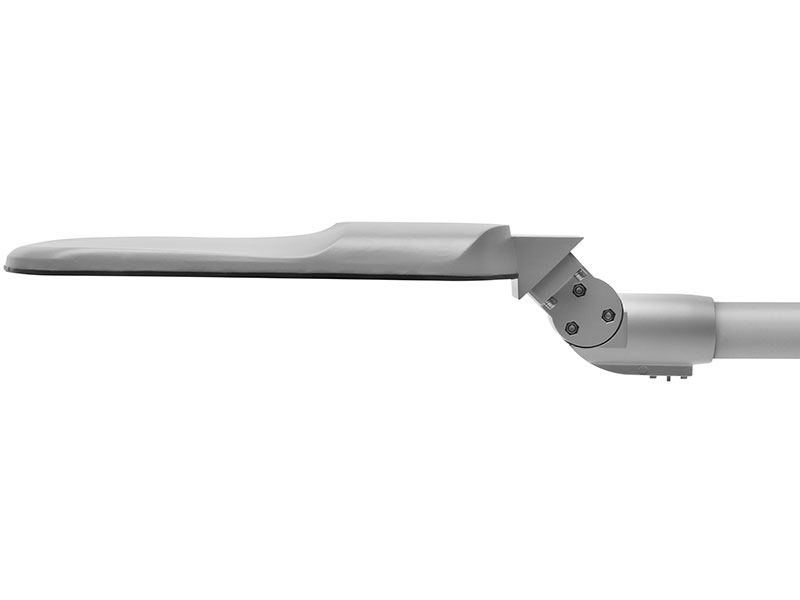Original lighting solution
Approximately 500 lights were installed in the streets of Gbely, a village in Záhorie region, Slovakia. Public lighting units were installed on the steel power line pillars. The pillars on main roads were distributed evenly, while those on the side roads were distributed unevenly. The lights were always situated on the one side of the road only.
Originally, gas-discharge lights and compact lights were installed. The original public lighting system was controlled by a twilight sensor (a problematic point as an interaction with nearby light sources can occur).
The 8 switchboards were checked and 30 non-functioning lights out of 499 lights were proven. As the original lighting system was outdated, a high consumption of electricity was another big problem.
The conditions of individual lights were different (some units were rusty and non-functional, some were more or less preserved). Generally, the lights had passed the half of the lifespan, what means they were 60% less efficient. The lighting became ineffective (lower light intensity while the consumption remained unchanged). Moreover the light distribution did not comply with the STN EN 13201.
The table shows the total number of lights and number of non-functional lights in the districts.
| Switchboard | Number of lights (number of non-functional lights) |
| Slnečná | 82 units (11 units) |
| Naftárska | 78 units |
| Pionierska | 84 units (8 units) |
| Farské | 30 units (3 units) |
| Čarského | 132 units (7 units) |
| Kostol | 10 units |
| Mládeže | 50 units |
| Lesná | 33 units (1 units) |
New lighting solution
An audit of the original lighting system conditions had been conducted before the new lighting solution was designed. As the original lighting system was outdated, we elaborated a new detailed lighting project aimed to:
- Reduction of the electricity consumption
- Maintaining a proper operation of the lighting system
- Increasing an efficacy of the individual lights
- Providing even illumination
- Reduction of the number of offtake points (number of lights)
- Placing the lights below the power line level
The original gas-discharge lights and compact light were replaced by energy saving LED lights Segin M 56W 5050lm (95 units for the main roads) and Segin M 28W 2600lm (405 units for the side roads). Input of the individual light is 56 W/28 W (the original light input was 126,4 W), depending on the type of the light. The main road lights have higher input, they have been placed a bit higher than the side road lights, and the pillars are more distant to each other.
Astronomical time switches and twilight sensors control the lighting system. Thus the entire lighting system is electronically controlled and it will never turn on by daylight (a common lighting system fail in villages).
Due to reduced electricity consumption and public lighting links of the new lighting system, we could reduce the total of switchboards by half (8 to 4 units). The offtake points (number of lights) reduction brings considerable costs reduction.
Savings achieved
Electricity consumption of the new lighting system is 22.81 kW (comparing to 63.1 kW of the original lighting system) – up to 63.8% saving on electricity.
Return on investment is 5.3 years.
Annual energy costs saving is 20,087.1 EUR. Annual maintenance costs saving is 2,204 EUR (LED Lighting solution is maintenance free and its operation time is more than 100,000 hours, approx. 25 years).
Total costs savings during the LED Light operation time is more than 557,277.5 EUR. CO2 emission reduction during the lights operation time can reach 3,000 tonnes.
Comparing the original solution vs. new solution
| Original solution | New solution | |
|---|---|---|
| Input per unit | 126,4 W | 28/54 W |
| No. of lights | 499 units | 500 units |
| Total input | 63.1 kW | 22.81 kW |
| Lifespan | 14,000 hours | 100,000 hours |
| Light efficacy | 60 % | 100 % |
| Annual energy costs | 31,672.24 EUR | 11,585.14 EUR |
| Annual maintenance costs | 2,204 EUR | 0 EUR |
| Saving per year | – | 22,291.1 EUR |




